1994 CHEVROLET SUBURBAN change time
[x] Cancel search: change timePage 252 of 385
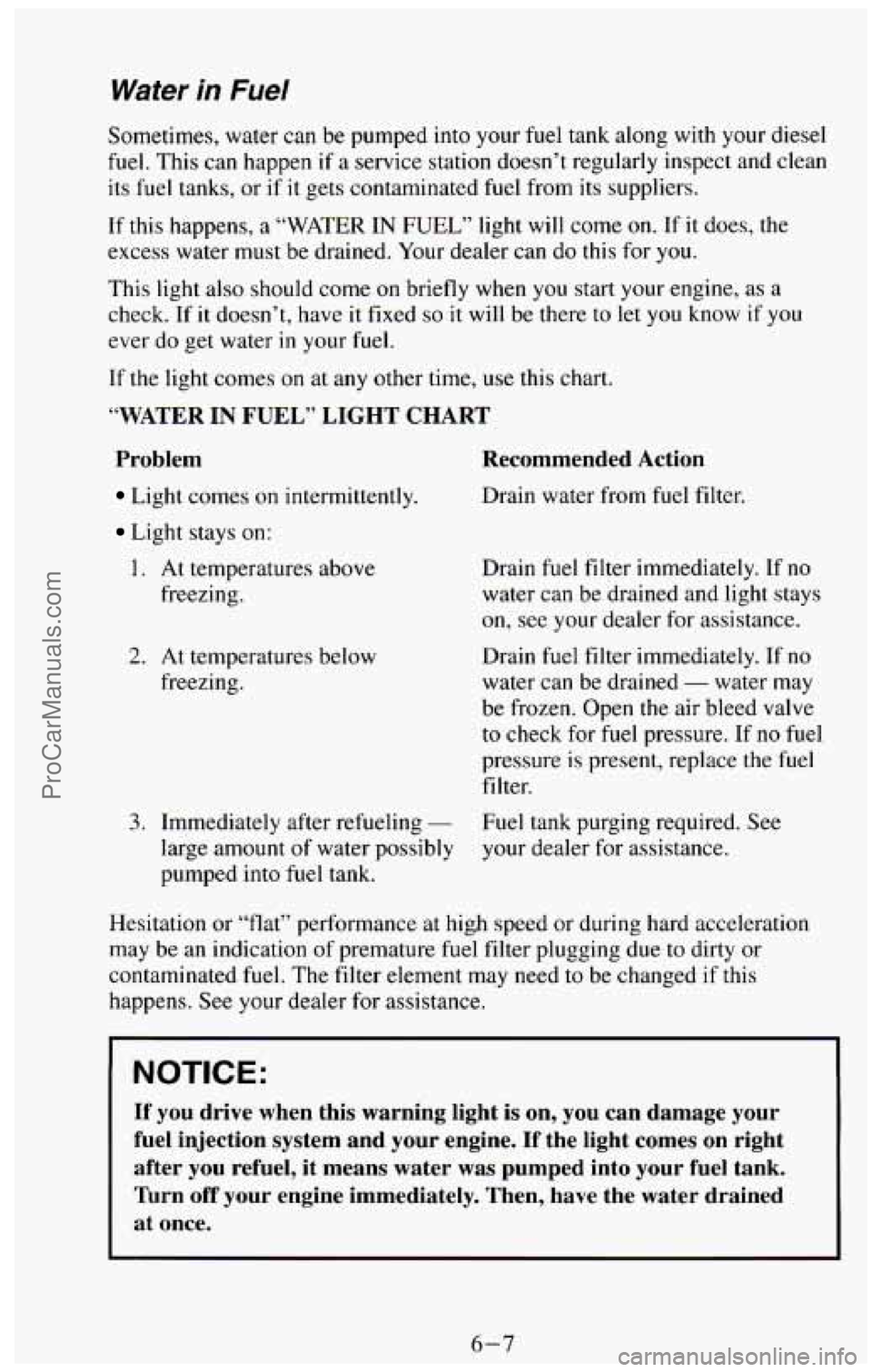
Water in Fuel
Sometimes, water can be pumped into your fuel tank along with your diesel
fuel. This can happen if a service station doesn’t regularly inspect and clean
its fuel tanks, or if it gets contaminated fuel from its suppliers.
If this happens, a “WATER IN FUEL” light will come on. If it does, the
excess water
must be drained. Your dealer can do this for you.
This light
also should come on briefly when you start your engine, as a
check. If it doesn’t, have it fixed so it will be there to let you know if you
ever do get water
in your fuel.
If the light comes on at any other time, use this chart.
“WATER IN FUEL” LIGHT CHART
Problem
Light comes on intermittently.
Light stays on:
1. At temperatures above
freezing.
2. At temperatures below
freezing.
Recommended Action
Drain water from fuel filter.
Drain fuel filter immediately.
If no
water can be drained and light stays
on, see your dealer for assistance.
Drain fuel filter immediately. If no
water can be drained
- water may
be frozen. Open
the air bleed valve
to check for
fuel pressure. If no fuel
pressure
is present, replace the fuel
fi 1 ter.
3. Immediately after refueling - Fuel tank purging required. See
large amount
of water possibly your dealer for assistance.
pumped into fuel tank.
Hesitation or “flat” performance at
high speed or during hard acceleration
may be an indication of premature fuel filter plugging due to dirty or
contaminated
fuel. The filter element may need to be changed if this
happens. See your dealer for assistance.
If you drive when this warning light is on, you can damage your
fuel injection system and your engine.
If the light comes on right
after you refuel,
it means water was pumped into your fuel tank.
Turn
off your engine immediately. Then, have the water drained
at once.
6-7
ProCarManuals.com
Page 255 of 385
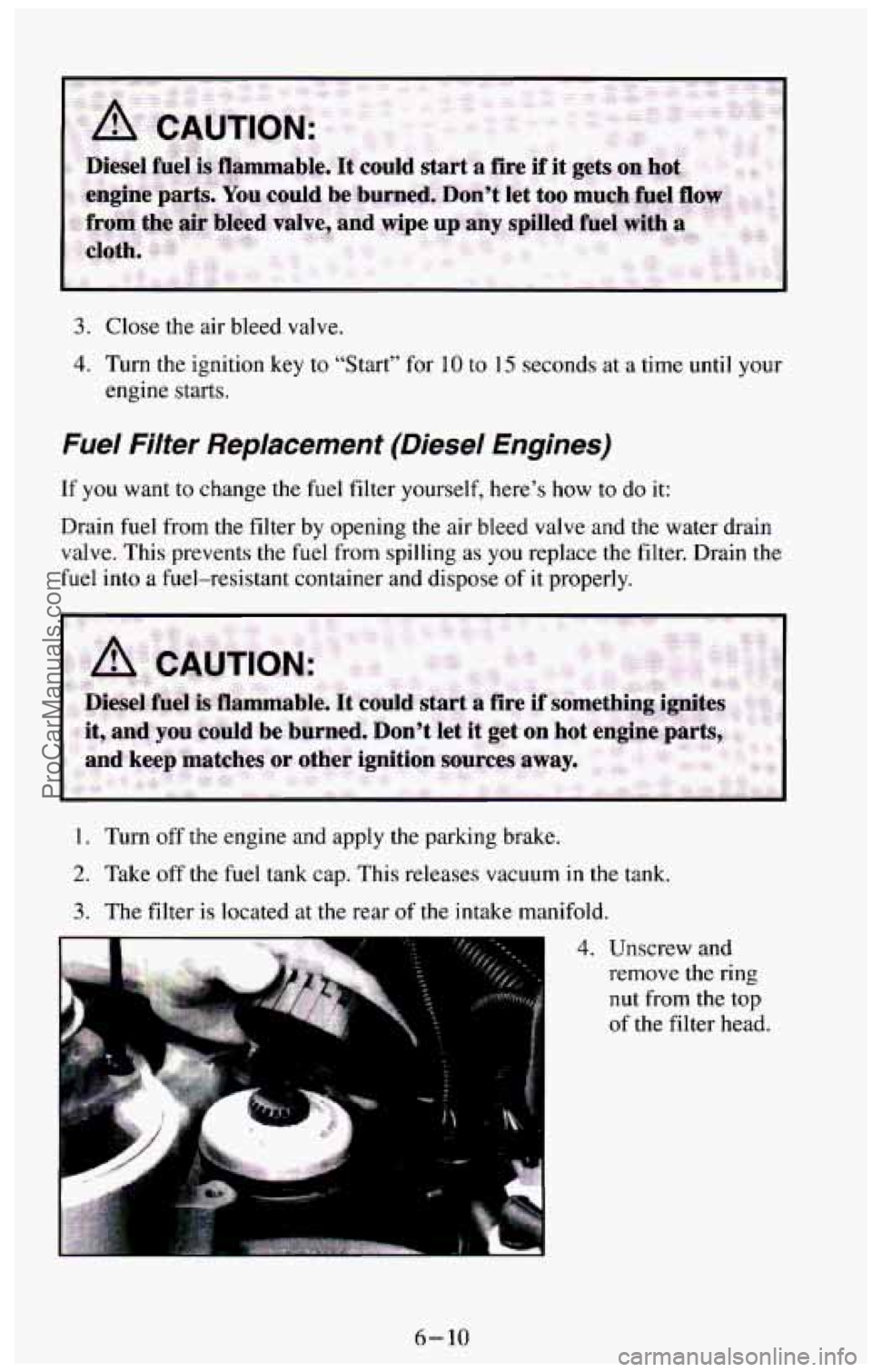
3. Close the air bleed valve.
4. Turn the ignition key to “Start” for 10 to 15 seconas at a time until your
engine starts.
Fuel Filter Replacement (Diesel Engines)
If you want to change the fuel filter yourself, here’s how to do it:
Drain fuel from the filter by opening the air bleed valve and the water drain
valve. This prevents the
fuel from spilling as you replace the filter. Drain the
fuel into a fuel-resistant container and dispose
of it properly.
1. Turn off the engine and apply the parking brake.
2. Take off the fuel tank cap. This releases vacuum in the tank.
3. The filter is located at the rear of the intake manifold.
4;: .
4. Unscrew and
remove the ring
nut from the top
of the filter head.
6- 10
ProCarManuals.com
Page 266 of 385
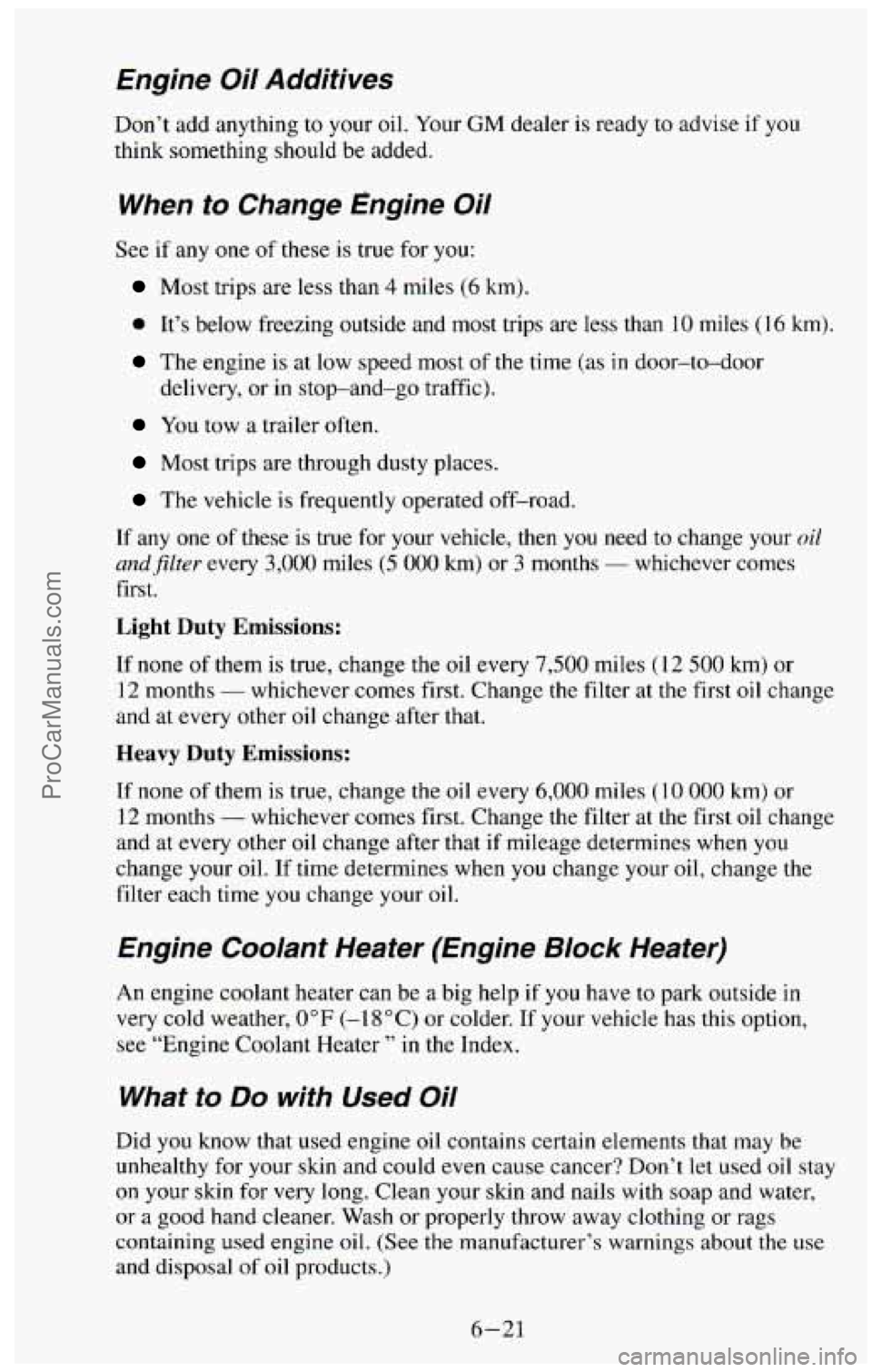
Engine Oil Additives
Don’t add anything to your oil. Your GM dealer is ready to advise if you
think something should be added.
When to Change Engine Oil
See if any one of these is true for you:
Most trips are less than 4 miles (6 km).
0 It’s below freezing outside and most trips are less than 10 miles (16 km).
The engine is at low speed most of the time (as in door-to-door
You tow a trailer often.
delivery,
or in stop-and-go traffic).
Most trips are through dusty places.
The vehicle is frequently operated off-road.
If any one
of these is true for your vehicle, then you need to change your oil
andfifilter every 3,000 miles (5 000 km) or 3 months - whichever comes
first
.
Light Duty Emissions:
If none of them is true, change the oil every 7,500 miles (12 500 km) or
12 months - whichever comes first. Change the filter at the first oil change
and at every other oil change after that.
Heavy Duty Emissions:
If none of them is true, change the oil every 6,000 miles ( 10 000 km) or
12 months - whichever comes first. Change the filter at the first oil change
and at every other oil change after that if mileage determines when you
change your oil.
If time determines when you change your oil, change the
filter each time you change your
oil.
Engine Coolant Heater (Engine Block Heater)
An engine coolant heater can be a big help if you have to park outside in
very cold weather,
0°F (-1 8 “C) or colder. If your vehicle has this option,
see “Engine Coolant Heater
” in the Index.
What to Do with Used Oil
Did you know that used engine oil contains certain elements that may be
unhealthy for your skin and could even cause cancer? Don’t let used oil stay
on your skin for very long. Clean your skin and nails with soap and water,
or
a good hand cleaner. Wash or properly throw away clothing or rags
containing
used engine oil. (See the manufacturer’s warnings about the use
and disposal of oil products.)
6-21
ProCarManuals.com
Page 267 of 385
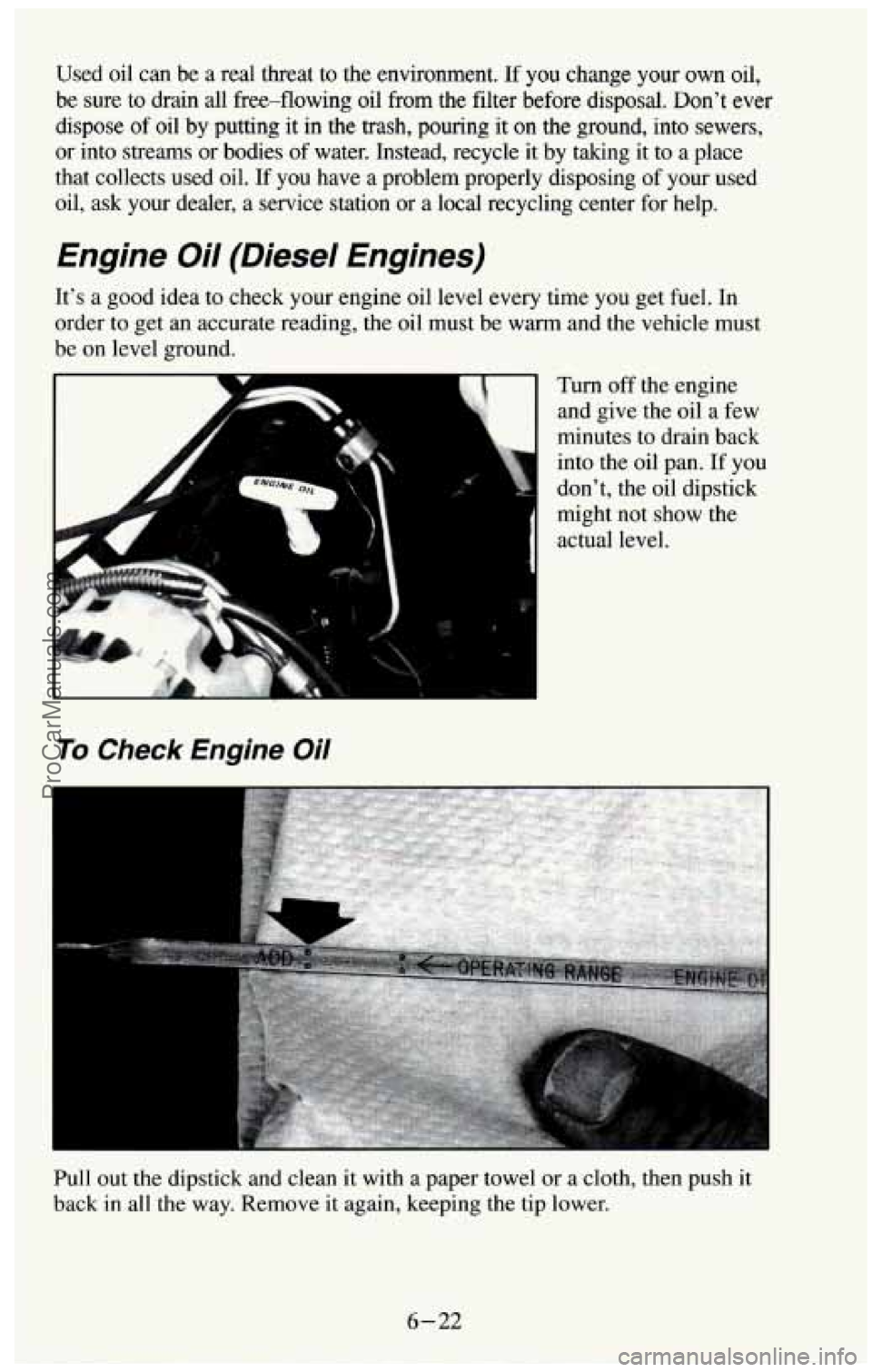
Used oil can be a real threat to the environment. If you change your own oil,
be sure to drain all free-flowing oil from the filter before disposal. Don't ever
dispose of oil by putting it in the trash, pouring it on the ground, into sewers,
or into streams or bodies of water. Instead, recycle it by taking it to a place
that collects used oil. If you have a problem properly disposing of your used
oil, ask your dealer, a service station or a local recycling center for help.
Engine Oil (Diesel Engines)
It's a good idea to check your engine oil level every time you get fuel. In
order to get an accurate reading, the oil must be warm and the vehicle must
be on level ground.
A
Turn off the engine
and give the oil a few
minutes to drain back
into the oil pan. If you
don't, the oil dipstick
might not show the
actual level.
To Check Engine Oil
Pull out the dipstick and clean it with a paper towel or a cloth, then push it
back
in all the way. Remove it again, keeping the tip lower.
6-22
ProCarManuals.com
Page 271 of 385
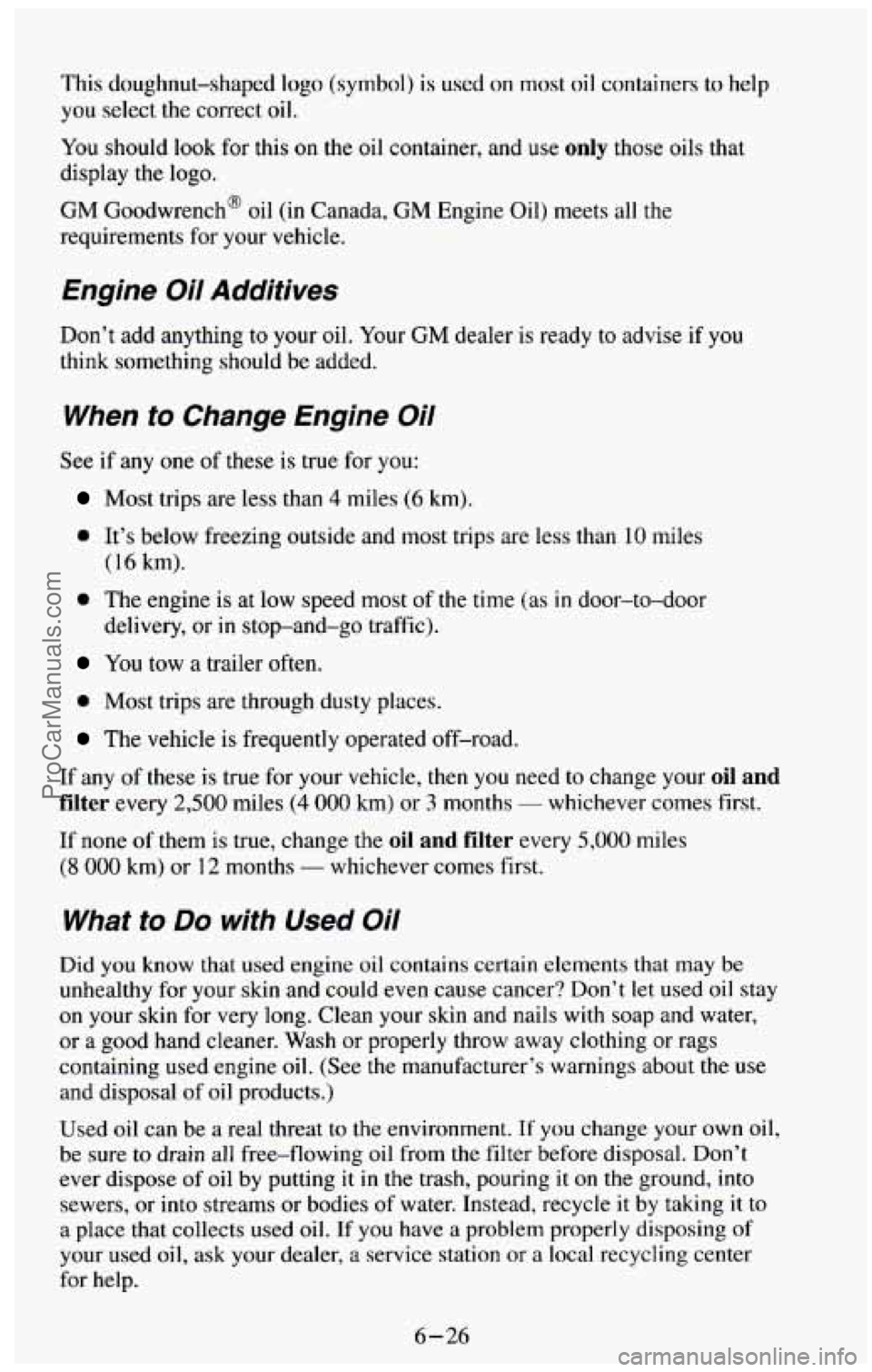
This doughnut-shaped logo (symbol) is used on most oil containers to help
you select the correct oil.
You should look for this on the oil container, and use only those oils that
display the logo.
GM Goodwrench@ oil (in Canada, GM Engine Oil) meets all the
requirements for your vehicle.
Engine Oil Additives
Don’t add anything to your oil. Your GM dealer is ready to advise if you
think something should be added.
When to Change Engine Oil
See if any one of these is true for you:
Most trips are less than 4 miles (6 km).
0 It’s below freezing outside and most trips are less than 10 miles
0 The engine is at low speed most of the time (as in door-to-door
(16 km).
delivery,
or in stop-and-go traffic).
You tow a trailer often.
0 Most trips are through dusty places.
The vehicle is frequently operated off-road.
If any
of these is true for your vehicle, then you need to change your oil and
filter
every 2,500 miles (4 000 km) or 3 months - whichever comes first.
If none of them is true, change the oil and filter every 5,000 miles
(8 000 km) or 12 months - whichever comes first.
What to Do with Used Oil
Did you know that used engine oil contains certain elements that may be
unhealthy for your skin and could even cause cancer? Don’t let used oil stay
on your
skin for very long. Clean your skin and nails with soap and water,
or
a good hand cleaner. Wash or properly throw away clothing or rags
containing used engine
oil. (See the manufacturer’s warnings about the use
and disposal
of oil products.)
Used oil can be a real threat to the environment.
If you change your own oil.
be sure to drain all free-flowing oil from the filter before disposal. Don’t
ever dispose of oil by putting
it in the trash, pouring it on the ground, into
sewers, or into streams
or bodies of water. Instead, recycle it by taking it to
a place that collects used oil. If you have a problem properly disposing of
your used oil,
ask your dealer, a service station or a local recycling center
for help.
6-26
ProCarManuals.com
Page 273 of 385
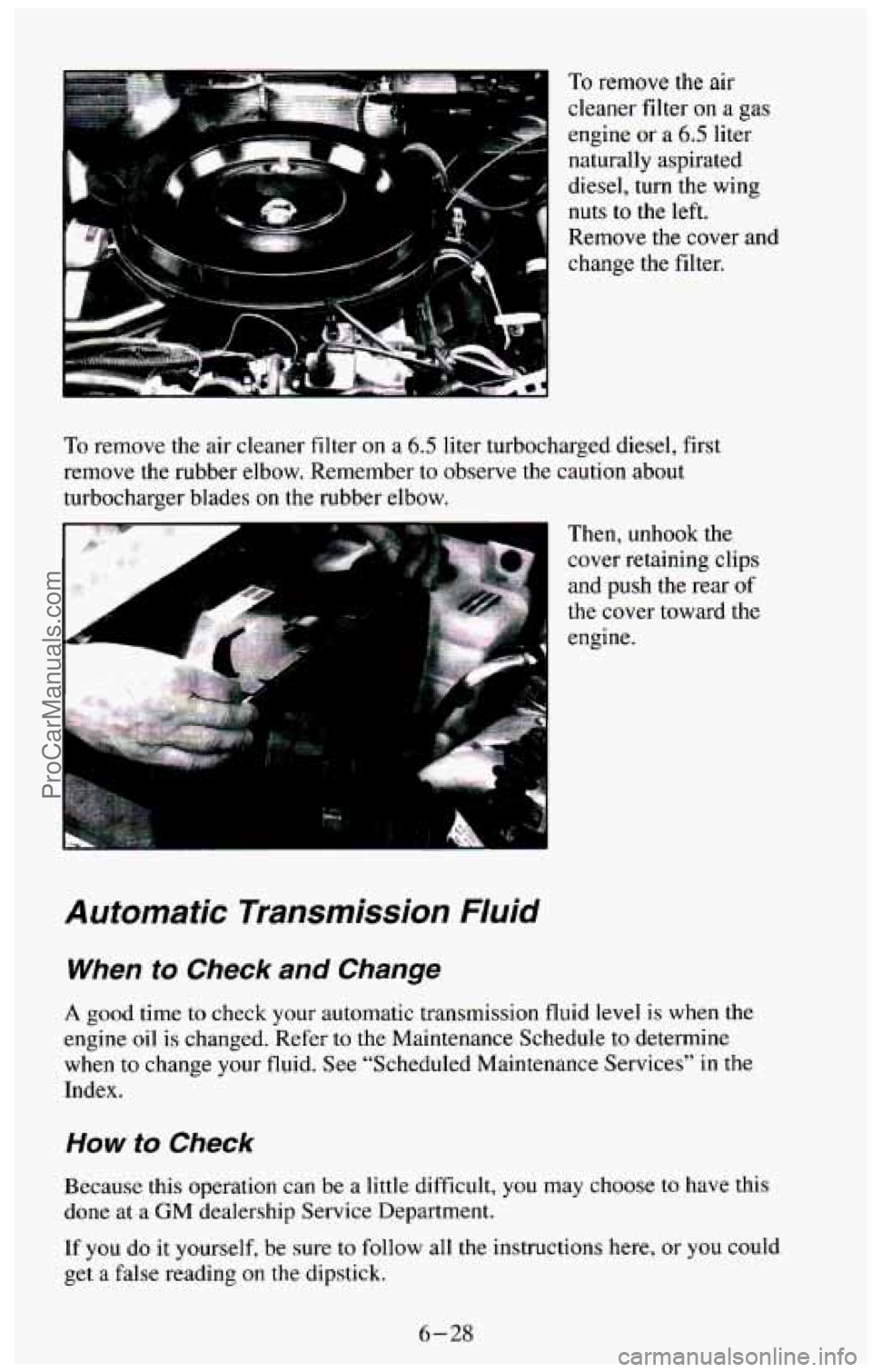
To remove the air
cleaner filter
on a gas
engine or
a 6.5 liter
naturally aspirated
diesel, turn the wing
nuts
to the left.
Remove the cover and
change the filter.
To remove the air cleaner filter on a 6.5 liter turbocharged diesel, first
remove the rubber elbow. Remember to observe the caution about
turbocharger blades on the rubber elbow,
Then, unhook the
cover retaining clips
and push the rear
of
the cover toward the
engine.
Automatic Transmission Fluid
When to Check and Change
A good time to check your automatic transmission fluid level is when the
engine
oil is changed. Refer to the Maintenance Schedule to determine
when to change your fluid.
See “Scheduled Maintenance Services” in the
Index.
How to Check
Because this operation can be a little difficult, you may choose to have this
done at a
GM dealership Service Department.
If you do it yourself, be sure to follow all the instructions here, or you could
get
a false reading on the dipstick.
6-28
ProCarManuals.com
Page 276 of 385
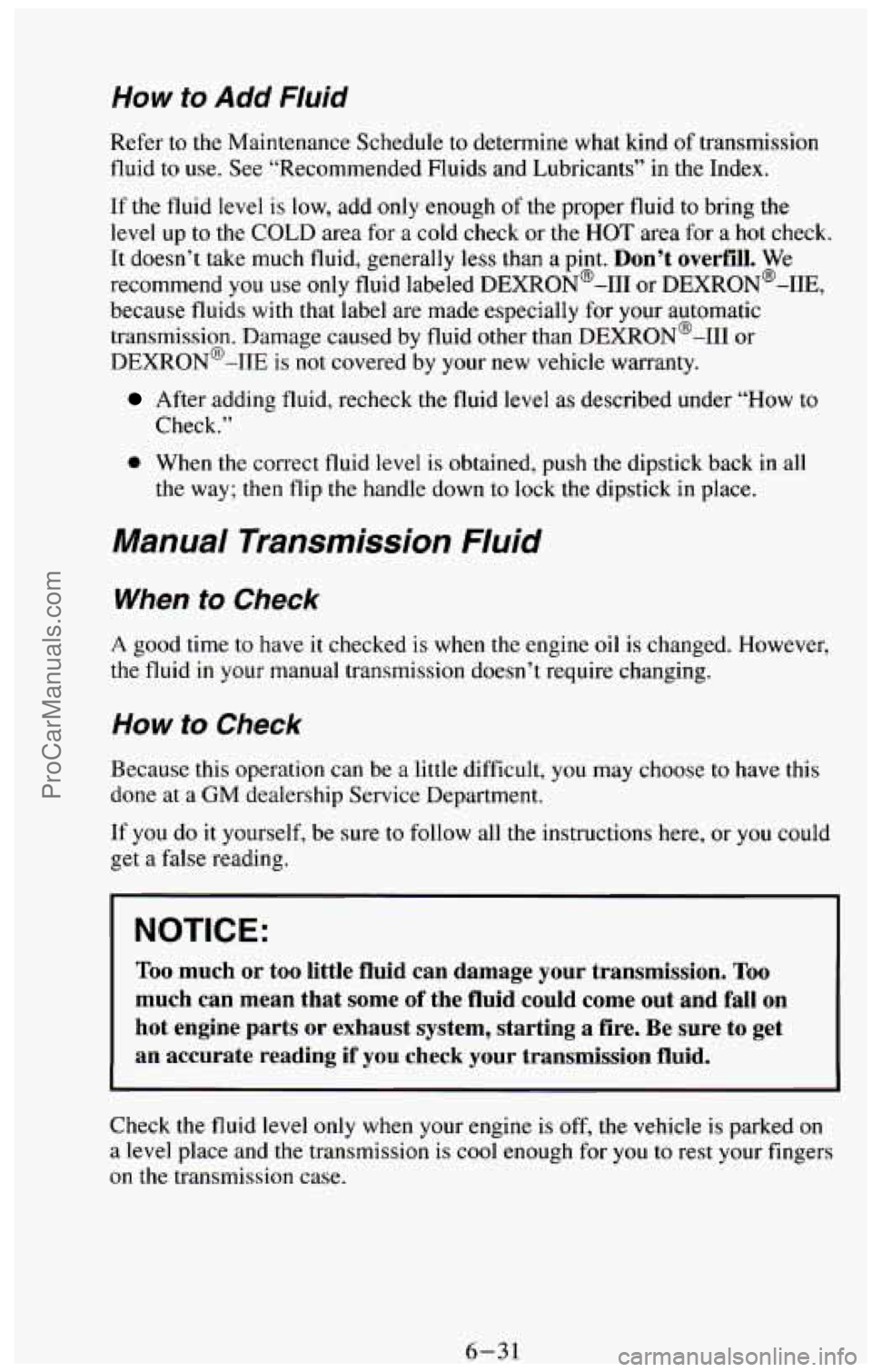
WOW to Add Fluid
Refer to the Maintenance Schedule to determine what kind of transmission
fluid to use. See “Recommended Fluids and Lubricants’’ in the Index.
If the fluid level
is low, add only enough of the proper fluid to bring the
level up to the
COLD area for a cold check or the HOT area for a hot check.
It doesn’t take much fluid, generally
less than a pint. Don’t overfill. We
recommend you use
only fluid labeled DEXRON@-I11 or DEXRON@-IIE,
because fluids with that label are made especially for your automatic
transmission. Damage caused
by fluid other than DEXRON@-I11 or
DEXRON@-IIE is not covered
by your new vehicle warranty.
After adding fluid, recheck the fluid level as described under “How to
Check.”
When the correct fluid level is obtained, push the dipstick back in all
the way; then flip the handle down to lock the dipstick
in place.
Manual Transmission Fluid
When to Check
A good time to have it checked is when the engine oil is changed. However,
the fluid
in your manual transmission doesn’t require changing.
How to Check
Because this operation can be a little difficult, you may choose to have this
done at a
GM dealership Service Department.
If you do it yourself, be sure to follow all the instructions here, or you could
get
a false reading.
NOTICE:
Too much or too little fluid can damage your transmission. Too
much can mean that some of the fluid could come out and fall on
hot engine parts or exhaust system, starting a fire. Be sure to get
an accurate reading if
you check your transmission fluid.
Check the fluid level only when your engine is off, the vehicle is parked on
a level place and the transmission is cool enough for you to rest your fingers
on the transmission case.
6-31 ProCarManuals.com
Page 326 of 385
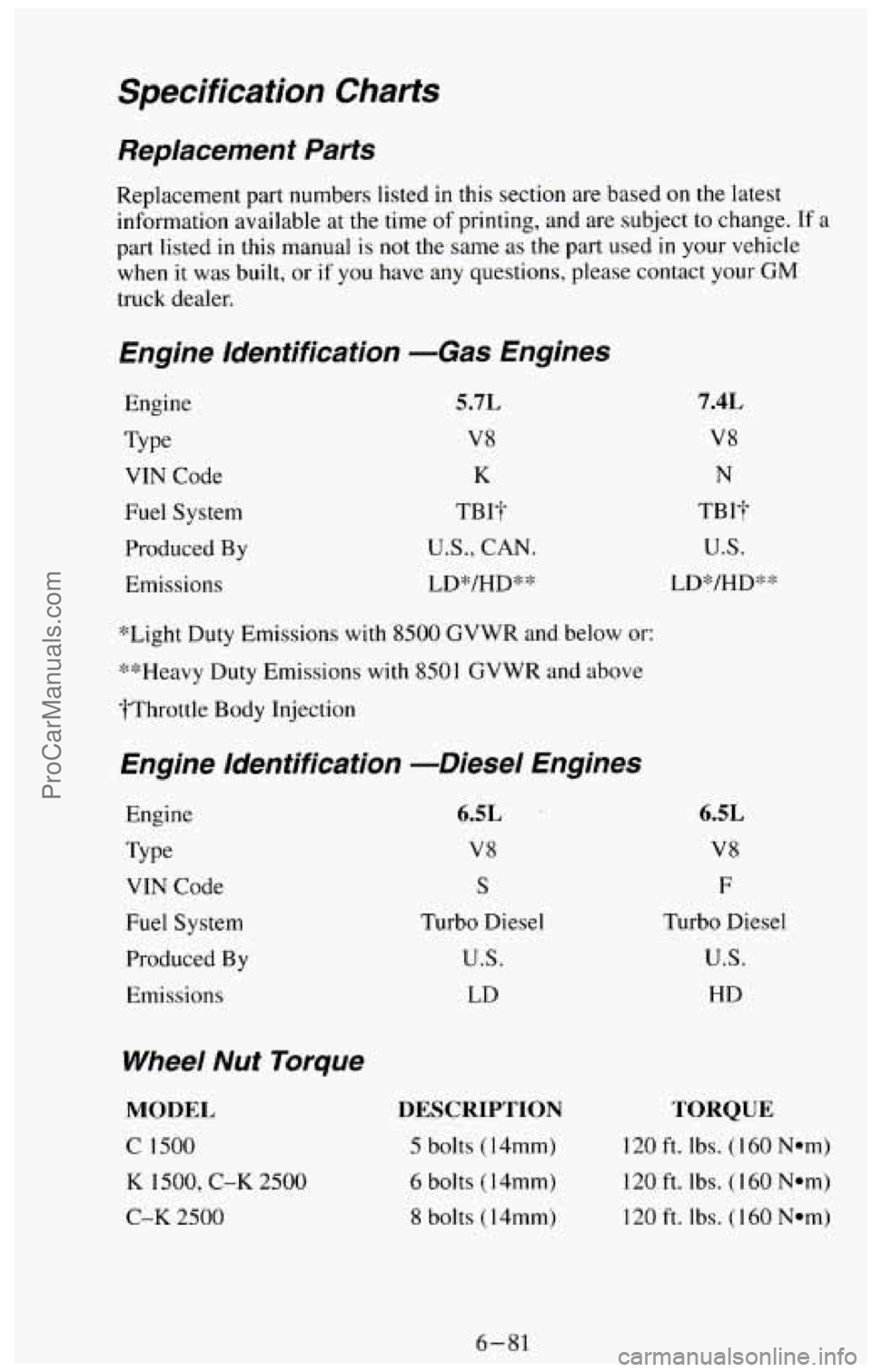
Specification Charts
Replacement Parts
Replacement part numbers listed in this section are based on the latest
information available
at the time of printing, and are subject to change. If a
part listed in this manual
is not the same as the part used in your vehicle
when
it was built, or if you have any questions, please contact your GM
truck dealer.
Engine Identification -Gas Engines
Engine
Type VIN Code
Fuel System
Produced By
Emissions
5.7L
V8
K
TBIT
U.S., CAN.
JJD*/HD**
“Light Duty Emissions with
8500 GVWR and below or:
**Heavy Duty Emissions with 8501 GVWR and above
?Throttle Body Injection
Engine Identification -Diesel Engines
Engine
Type VIN Code
Fuel System
Produced By
Emissions
Wheel Nut Torque
MODEL
C 1500
K 1500, C-K 2500
C-K 2500
6.5L
V8
S
Turbo Diesel
U.S.
LD
DESCRIPTION
5 bolts (14mm)
6 bolts (14mm)
8 bolts (14mm)
6.5L
V8
F
Turbo Diesel
U.S.
HD
TORQUE
120 ft. lbs. (1 60 Nom)
120 ft. lbs. ( 1 60 Nom)
I20 ft. Ibs. (I 60 Nom)
6-81
ProCarManuals.com